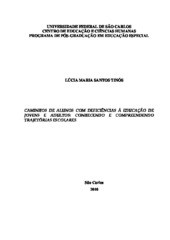| dc.contributor.author | Tinós, Lúcia Maria Santos | |
| dc.date.accessioned | 2016-06-02T19:44:07Z | |
| dc.date.available | 2010-12-07 | |
| dc.date.available | 2016-06-02T19:44:07Z | |
| dc.date.issued | 2010-11-12 | |
| dc.identifier.citation | TINÓS, Lúcia Maria Santos. The paths of handicapped students towards education of youngsters and adults: acknoledging and understanding educational trajectories. 2010. 137 f. Tese (Doutorado em Ciências Humanas) - Universidade Federal de São Carlos, São Carlos, 2010. | por |
| dc.identifier.uri | https://repositorio.ufscar.br/handle/ufscar/2872 | |
| dc.description.abstract | Studies indicate that the Youngster and Adult Education program has been increasingly used as an educational resource by handicapped people. Although the last decades has shown progress in the legislation aiming to assure the right to a quality education for the students with special needs, including the handicapped ones, based on the principle of an Inclusive Education for all, the question is how the educational services special or regular - are being assured and taken into account for these individuals stands. Based on this question, the objective of this study was to understand the educational trajectories of the handicapped students that are participating in the Youngster and Adult Education program, worth the aim of, better definig the different educational services experienced by these students, including the Youngster and Adult Education program itself. To achier does, it were carried out interviews with two handicapped women enrolled in the Youngster and Adult Education program, and their mothers. For the data analysis, phenomenological understandings were selected, having as a principle the units of meanings, in order to unveil the understandings and meanings of each participants, perceptions then world of interpretations of the experienced contexts. The description of educational trajectories enabled the understanding of some aspects of the educational services (the Special School, the Special Education Classroom, the Regular Education Classroom (Inclusion) and the Youngster and Adult Education program Classes). The understanding analysis allowed to point out convergences and divergences of the analyzed processes: pedagogical attendance; academic degree; exclusion situations; welcoming; referral; certification; right or assurance; inclusion; education and work world, all descend lousy the legislations in effect. Thus, it was observed in these trajectories that the progresses in the legislation regarding the assurance of the right to a quality education, and, in this case, towards the handicapped students, still need to be put into effect with seriousness and real conditions. That these educational services, including the youngster and adult Education program, start to be thought and guaranteed for public politics that recognize the right and the necessities of the handicapped student. | eng |
| dc.format | application/pdf | por |
| dc.language | por | por |
| dc.publisher | Universidade Federal de São Carlos | por |
| dc.rights | Acesso Aberto | por |
| dc.subject | Educação especial | por |
| dc.subject | Inclusão escolar | por |
| dc.subject | Educação de jovens e adultos | por |
| dc.subject | Deficiência | por |
| dc.subject | Handicapped youngster and adult education | eng |
| dc.subject | Inclusion and special education | eng |
| dc.title | Caminhos de alunos com deficiências à educação de jovens e adultos: conhecendo e compreendendo trajetórias escolares | por |
| dc.title.alternative | The paths of handicapped students towards education of youngsters and adults: acknoledging and understanding educational trajectories | eng |
| dc.type | Tese | por |
| dc.contributor.advisor1 | Denari, Fátima Elisabeth | |
| dc.contributor.advisor1Lattes | http://lattes.cnpq.br/5575213011914394 | por |
| dc.description.resumo | Pesquisas indicam que a Educação de Jovens e Adultos (EJA) tem sido usada, de forma crescente, como recurso educacional por pessoas com deficiências. Embora as últimas décadas mostrem avanços na legislação, na busca por garantir o direito a uma educação de qualidade, para os alunos com necessidades educacionais especiais, inclusive os com deficiência. Com base no princípio de uma Educação Inclusiva para todos, fica a questão de como vem sendo assegurado e efetivado o serviço escolar especial ou regular para esta população. Nesse contexto, o objetivo deste trabalho foi reconhecer e desvelar as trajetórias escolares de alunos com deficiência e, assim, melhor compreender e (re)significar os diferentes serviços educacionais por estes vivenciados. Para tal, por meio de entrevistas com duas jovens com deficiências, matriculadas na EJA, e suas mães, buscou-se a compreensão do fenômeno pesquisado. Para as análises dos dados, utilizou-se entendimentos fenomenológicos, tendo por princípio unidades de significados, para desvelar as vivências e significados das percepções de cada participante em um mundo de interpretações do contexto vivido. Como resultados, as descrições das trajetórias escolares possibilitaram entender alguns aspectos dos serviços educacionais (a Escola Especial, a Classe Especial, a Classe Regular (Inclusão) e as Salas de EJA). E a análise compreensiva permitiu destacar as convergências e divergências dos processos analisados: atendimento pedagógico; certificação; situações de exclusão; acolhimento; encaminhamento; terminalidade; garantia de direito; inclusão; formação e mundo do trabalho, com reflexões em relação às legislações vigentes. Assim, verificou-se, nestas trajetórias, que os avanços na legislação, referentes à garantia do direito à educação de qualidade, e neste caso para com os alunos com deficiência, ainda estão para serem efetivados com maiores condições, e que estes serviços educacionais, incluindo a EJA, passem a serem pensados e garantidos por políticas públicas que reconheçam o direito e as necessidades dos alunos com deficiência. | por |
| dc.publisher.country | BR | por |
| dc.publisher.initials | UFSCar | por |
| dc.publisher.program | Programa de Pós-Graduação em Educação Especial - PPGEEs | por |
| dc.subject.cnpq | CIENCIAS HUMANAS::EDUCACAO::TOPICOS ESPECIFICOS DE EDUCACAO::EDUCACAO ESPECIAL | por |
| dc.contributor.authorlattes | http://lattes.cnpq.br/9102713410545596 | por |
